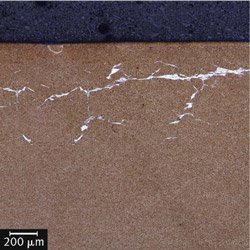
Posted to News on 25th Aug 2015, 12:18
Prevention of white etching cracks in rolling bearings
The formation of white etching cracks (WEC) in rolling bearings can lead to their premature failure. However, a number of innovative approaches have been developed that significantly reduce the risk of WEC, says Dr Steve Lacey, engineering manager at Schaeffler UK.

White etching cracks (WEC) is a phenomenon that can significantly shorten the reliability and operating life of bearings, both in the wind power industry and in a number of industrial applications.
WEC are structural changes in the material that form below the surface of the bearing. These changes result in the formation of cracks, which extend to the surface during stress conditions under different external loads. As a result, the bearing inner or outer ring can eventually crack, leading to the premature failure of the bearing. These cracks are known to occur in both through hardened and case hardened rolling bearings.
In the wind power industry, the development of larger, multi-megawatt wind turbines has resulted in significantly higher forces and torques, which in turn means that turbine components such as bearings are subjected to even higher loads. At the same time, any downtime or maintenance required on turbine components will result in increased costs, particularly in the case of offshore wind farms. Reliability of components is therefore of the utmost importance.
As well as bearings for wind turbines, WEC can also occur in bearings used in other industrial applications such as electric motors, paper mills, industrial gearboxes (e.g. in large hydraulic excavators), pump systems, marine drives and automotive applications.
What causes WEC?
Influences that could have an effect on component fatigue, such as contact pressure, insufficient level of steel purity, or overloading, do not cause WEC to occur. In fact, it is still not completely clear what actually causes WEC to occur. However, according to the latest research, additional stresses in the form of dynamics, mixed friction and the effects of electrical systems are most likely to create the conditions required for WEC to form.
Today, a number of innovative options are available that increase the resistance of bearings to white etching cracks and therefore help to prevent the premature failure of bearings.
As a bearing supplier, Schaeffler has invested in comprehensive test facilities for creating white etching cracks, the causes of which can then be analysed and concept solutions developed for reducing the risk of WEC. This research has enabled Schaeffler to reduce the risk of WEC occurring by optimising the design of its bearing and by selecting the most appropriate lubricants and materials for individual bearing components. An optimum bearing design can reduce the stress placed on the bearing, which in turn, can allow it to be subjected to higher loads by matching the lubrication and preservation concepts with optimum material selection.
Failure rate of less than 0.02 per cent
The approach that Schaeffler recommends and has statistically verified for the efficient, cost-effective reduction of WEC damage is the through hardening of the bearings in combination with a black oxide coating on the inner ring, outer ring and rolling elements.
Through continuous optimisation, experts at Schaeffler's Surface Technology Competence Centre in Germany have developed a coating system that significantly increases a bearing's resistance to WEC. The Durotect B coating system has been consistently developed from conventional black oxide finishes to give increased performance. This coating minimises the risk of damage caused by slippage, improves run-in behaviour, provides increased corrosion resistance and increases the level of protection against WEC.
In the last few years, WEC has occurred in less than 100 out of 482,000 through hardened bearings coated with Durotect B that were manufactured and delivered by Schaeffler for use in wind turbine applications. This equates to a failure rate of less than 0.02 per cent.
Mancrodur with Durotect B
For applications that require high load ratings, Schaeffler also offers rolling bearings made from Mancrodur carbonitrided steel and coated with Durotect B. Carbonitriding involves subjecting the bearings to a special heating process in which the bearing surface is enriched with carbon and nitrogen. This increases the surface hardness and wear resistance of the bearing.
Cronidur 30 steel with high chromium
According to current knowledge, Cronidur special steel with high chromium content can be used to completely eliminate the risk of WEC. Consequently, there has never been a known case of WEC with Cronidur 30 bearings.
Cronidur 30 is a martensitic through hardened steel that, because of its alloy composition - carbon, nitrogen, chromium and molybdenum - exhibits exceptional corrosion resistance, strength, durability and high temperature hardness.
An inspection programme carried out by Schaeffler to determine individual options for different applications and additional stresses, showed that no cases of WEC occurred in bearings with Cronidur 30. The use of this material also allows the load rating to be increased by up to 70 per cent. The bearing rating life is therefore extended and the degree of corrosion protection is also improved.
As a development partner to the wind power sector, Schaeffler produces high-performance bearings for rotor shafts, gearboxes, generators and wind tracking systems. State-of-the-art calculation and simulation software programs ensure that optimum designs can be developed for wind power bearing applications. Using these software programs, the entire system is considered, starting from a single rolling bearing and its components through to the adjacent construction and the entire power transmission system. This comprehensive service that Schaeffler offers for wind turbines also includes a range of remote condition monitoring systems and diagnostic programmes.
For more information about white etching cracks (WEC) in rolling bearings please go to www.schaeffler.co.uk.






























